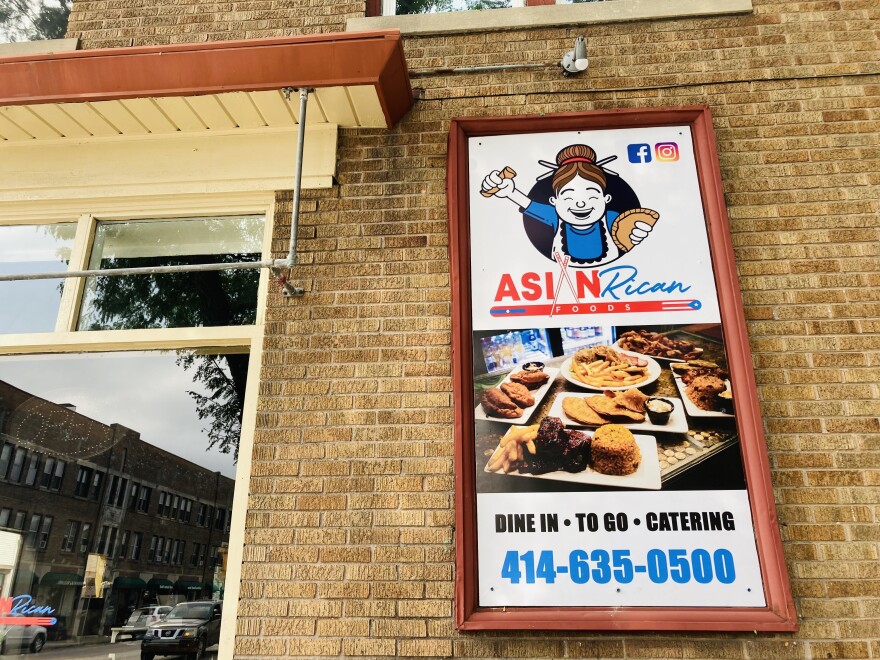In the kitchen of AsianRican Foods, a cook fires up some carne frita, big hunks of fried pork. It reminds me of a Chinese dish: roast pork belly. While pork sizzles in the fryer, she makes mofongo to go with it, pounding fried plantains with chicharron, spices, and lots of garlic.
The restaurant sits on Lincoln Avenue in Layton Park, among taco trucks, Puerto Rican bakeries, and Mexican restaurants.
It’s one of a few so-called fusion restaurants that have recently opened and are serving Asian-Latino cuisine. AsianRican Foods just opened the brick and mortar location, after a year of pop-up kitchens.
Another is Día Bom. In January, it opened in the Crossroads Collective food hall on the east side.
There, you can get beer-braised pork belly, topped with pickled red onion, mole rojo, and kimchi made with nopales, or cactus. It’s the creation of chef and owner Ramses Alvarez. He said the dish embodies his passions — plus a nod to Milwaukee.
“I love Korean food, I love Asian food,” Alvarez said. “I love my Mexican food, of course.”

In January, Alvarez opened Día Bom, which means “good day” in Portuguese. They serve Chinese bao and Japanese skewers, with Latin ingredients like mole and chorizo.
Alvarez has been a chef in the city for 20 years. He said he’s inspired by Milwaukee’s diversity. After moving from Mexico City, where he was born and raised, he spent a lot of time on the south side.
He loved El Rey, the Hispanic grocery store. Recently, he went for some malanga root, which makes beautiful, purple-speckled chips, he said. He saw a diverse mix of people shopping for many of the same ingredients.
“I saw an Asian family buying some yucca and some malanga too,” Alvarez said. “Different cultures walking around in the aisles buying papaya, buying jicama, dragon fruit, radishes. It’s just incredible.”
That kind of experience helped him make connections between the Mexican food of his home and the Asian food he loved as a child. He researches ingredients to understand how they’re used, and how they sometimes play similar roles. Take gochujang, for instance, a sweet and spicy red chili paste that lays the foundation for many Korean dishes.
“Classic gochujang sauce [is] fermented rice and chiles,” he said. “I was like, ‘Wow, that looks like a mole!’”
Alvarez said there’s a responsibility that comes with using ingredients from a culture that’s not your own.
“You can’t just put stuff together and call it fusion,” he said. “More than anything, the most important [thing] is respecting the ingredient and respecting the culture."
Meanwhile, at AsianRican Foods, the marriage of different cuisines mirrors one family’s story.
Chef and owner Julie Valcarcel is Laotian, her husband Moses is Puerto Rican. She used to work in finance, but always cooked for her family, which means a lot of food, whether for her six kids or her son’s high school football team. Her kids are picky, so she always mixed things up.
“We cannot have the same dish every single day,” Valcarcel said. “It’s always became like, let’s do Italian and Puerto Rican, let’s do Laotian and Chinese food. Definitely, that’s where the taste buds came from.”
At Asian Rican, you can pair meat dishes like Chinese BBQ pork or pinchos with Laotian sticky rice, fried rice, or arroz con gandules, a Puerto Rican staple of rice and pigeon peas. There are fried snacks like egg rolls, empanadas, and tostones. They come with two sauces.
“There’s the sweet and sour that Julie makes herself, and then the mayoketchup, which is a typical sauce that you would have with the fried food in Puerto Rico,” said Leo Vega, Valcarcel’s godson, who helps out at the restaurant.

Valcarcel learned to cook Chinese dishes from her father, who was half-Chinese. She learned Puerto Rican recipes after moving to Milwaukee and spending time with her husband’s family.
“Just seeing either my mother-in-law, my aunt, just seeing how they do things,” Valcarcel said, is how she picked up their recipes and techniques. “Watching them do things from start to finish, the old-fashioned way.”
Puerto Rican Chinese cuisine is common on the island, due in part to a long history of immigration that dates back to the Chinese Exclusion Act in 1882. That drove Chinese immigrants from the mainland U.S. to Puerto Rico.
But Valcarcel said they’re Milwaukee’s first Asian-Puerto Rican restaurant. Diners of all backgrounds are enjoying it.
“We get African Americans, caucasians, Mexicans, Dominicans, Puerto Ricans, Asian people, Laotian people, Chinese people — this food is meant for everyone,” she said.
Fusion food is sometimes criticized. It can present a culture’s staple ingredients as exotic. The term can also oversimplify the backgrounds of multicultural cooks like Valcarcel.
Vega, the Valcarcels’ godson, put it this way: “For us, I think it’s more of what the family is. This is what we grew up eating. You see this food — this is who we are.”






